Name Peralta In service 1926 Name Kalakala Displacement 1.338 million kg Added to NRHP 22 March 2006 | Launched 1926 Out of service 1933 Length 84 m Year built 1926 | |
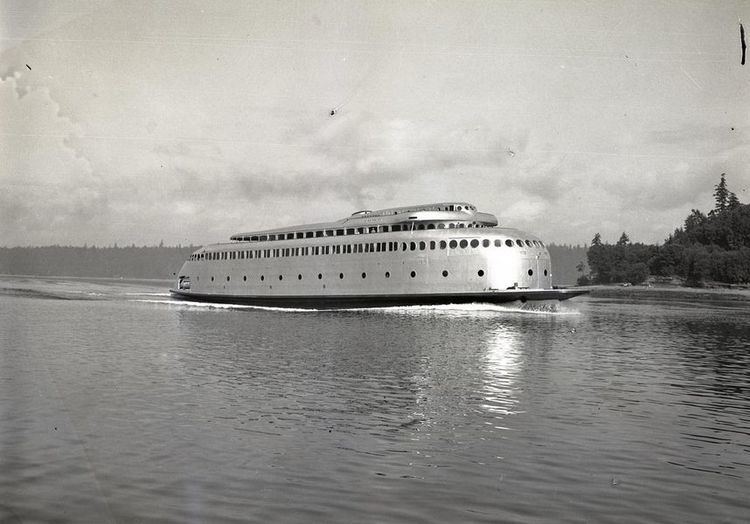 | ||
Status Severely damaged by fire, later restored Owners Key System, Puget Sound Navigation Company Similar Virginia V , Rich Passage , Seattle–Bainbridge ferry | ||
The mv kalakala art deco ferry boat underway with passengers on its inaugural pug hd stock footage
Motor Vessel Kalakala (pronounced /kəˈlɑːkəˌlɑː/) was a ferry that operated on Puget Sound from 1935 until her retirement in 1967.
Contents
- The mv kalakala art deco ferry boat underway with passengers on its inaugural pug hd stock footage
- Service
- Retirement
- Scrapping
- Artistic projects
- References
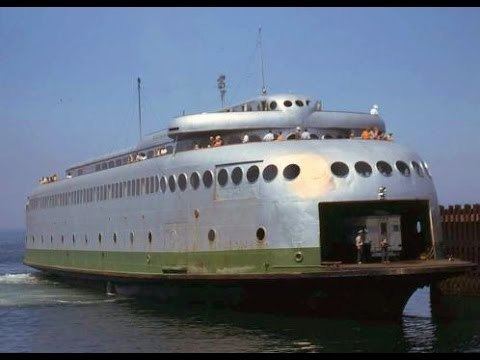
MV Kalakala was notable for her unique streamlined superstructure, art deco styling, and luxurious amenities. The vessel was a popular attraction for locals and tourists, and was voted second only to the Space Needle in popularity among visitors to Seattle during the 1962 Seattle World's Fair. The ship is known as the world's first streamlined vessel for her unique art deco styling.
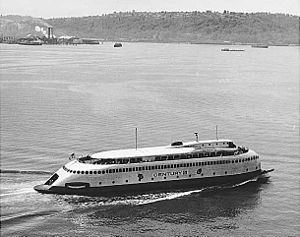
Service

She was constructed in 1926 as Peralta for the Key System's ferry service on San Francisco Bay. On 6 May 1933 Peralta burned as a result of an arson fire at the terminal where she was moored, resulting in the complete destruction of her superstructure. The hull was still intact and on 12 October 1933 the vessel was sold to the Puget Sound Navigation Company (PSNC), also known by its marketing name, the "Black Ball Line". PSNC funded a refit at Lake Washington Shipyards in Houghton, Washington (since annexed to Kirkland) to restore the vessel as a ferry.
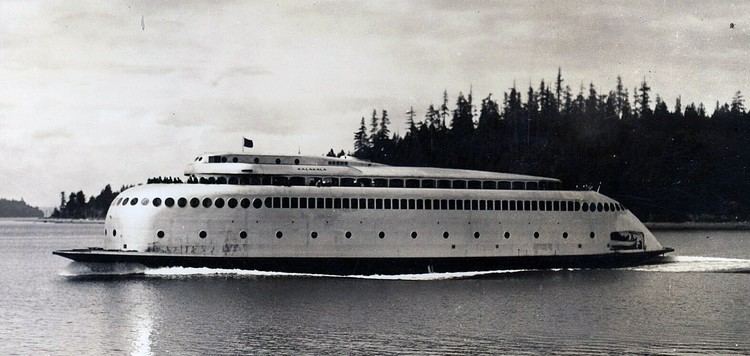
Kalakala's radical new superstructure design was inspired by contemporary aircraft. Louis Proctor, an engineer for the Boeing Company, provided an early concept design after the wife of PSNC's owner suggested that the new design should be distinctive and modernistic. The setback of the wheelhouse mimicked the setback of a cockpit behind the nose of an airplane. The flying bridge had no functional purpose but was evocative of wings, fitting with the aircraft-themed design.

The new electro-welding, or arc-welding, process was used instead of rivet construction, lending a seamless appearance to fit with the streamlined design. Kalakala was the first vessel on which the new technique was used. The new bridge and wheelhouse were built entirely out of copper, from fear that the steel used in the rest of the vessel would interfere with the ship's compass.
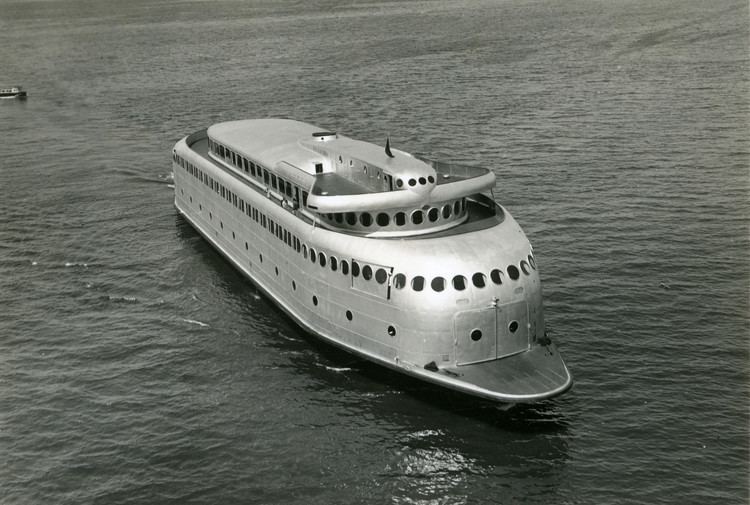
In November 1934, William Thorniley, publicist for PSNC and president of the Olympic Peninsula Travel Association, named the new ferry Kalakala, which was said to mean "bird" in the Pacific Northwest Native American trade language Chinook Jargon. Thorniley launched a national promotional campaign beginning with large billboard signs that simply said "KALAKALA!" Later, they said "KALAKALA, Seattle, WA" and featured a picture of the vessel as well.
After festivities, Kalakala entered service on July 4, 1935, instantly becoming an icon. She became the second most photographed object in the world, following the Eiffel Tower (the Golden Gate Bridge wasn't completed until 1937). The Kalakala experience featured a modernistic art-deco interior with a full-service galley, a ladies' lounge, and a men's taproom. In addition to ferry service, she was used for "moonlight cruises" with a live dance orchestra.
Kalakala saw heavy service during World War II transporting shipyard workers and Navy personnel between Seattle and Bremerton on an extended schedule. Vandalism and rowdiness brought deployment of the Shore Patrol and closure of the taproom. That service led to the moniker, "The Workhorse of Puget Sound."
Kalakala was featured transportation for tours of the Bremerton shipyards during the Seattle World's Fair in 1962.
The aircraft-inspired design of Kalakala sacrificed functionality. The setback of the wheelhouse made it impossible to see the bow of the vessel, leading to difficulties when docking. The car deck was narrowed for the sake of form, sacrificing lane width. That led to a 40% drop in the number of vehicles that could be carried as American cars became wider in the postwar years, with a corresponding drop in economic efficiency. With the coming of the more efficient Evergreen State class boats in the mid-1950s, Kalakala became obsolete. The enclosed bow design did, however, make her suitable for open water routes such as the Port Angeles - Victoria run, where she served from 1955 to 1959.
Kalakala had a heavy shaking vibration that ran throughout the vessel when in operation. This was probably due to poor alignment of the engines in the original construction of the vessel. When the propeller was replaced with a new 5-bladed version in 1956, the vibration was reduced by 40%. Although the company wished Kalakala to be known as the Silver Swan, she soon attracted other, less complimentary nicknames, including Silver Slug, Silver Beetle, Galloping Ghost of the Pacific Coast, and, among Seattle's Scandinavian community, Kackerlacka, which means "cockroach".
In February 1946, Kalakala was issued Federal Communications Commission (FCC) license #001 for the first commercial radar system.
Retirement
After her retirement in 1967, Kalakala was sold to a seafood processing company and towed to Alaska to work as a factory ship. After a period spent working as a crabbing ship in Ouzinkie, Alaska, the Kalakala was beached in Kodiak in 1970 and used to process shrimp.
Peter Bevis discovered the rusting hulk on a fishing trip in 1984. Kalakala had been turned into a cannery and the internal structure had been reworked to create a building with cement floors, drywall, and ceiling tiles. After complicated financial negotiations, the ship was refloated and towed back to Seattle in 1998. The vessel became a source of controversy for the remainder of her existence as her owners were unable to raise sufficient funds to refurbish the vessel or even to keep her moored in Seattle's Union Bay.
The vessel was sold in 2004 to a private investor, who moved her to an anchorage in Neah Bay provided by the Makah people. Soon after arriving at Neah Bay Kalakala was evicted by the Makah, who also brought a lawsuit against the owners. The vessel was then relocated to Tacoma, Washington.
In February 2008, Kalakala owner Steve Rodrigues announced his intention to acquire additional vintage ferry vessels and to restore them and the Kalakala as either ferries powered by wind and solar technologies or as museums. Kalakala was scheduled for work on her hull and superstructure in dry dock in 2010, but this never happened. After six years in Tacoma, Kalakala began listing, and officials became concerned that the ferry might pose an environmental risk. The vessel's owner was also pressured to take action after Washington State passed a law focusing on the removal of abandoned or neglected vessels. For these reasons, Kalakala's owner put her up for sale for a nominal fee of one dollar, contingent on the purchaser committing to renovating Kalakala.
In December 2011, the Coast Guard declared the ship a hazard to navigation. Among other issues, the Coast Guard stated that her mooring arrangements were inadequate. The Coast Guard set a December 19 deadline for the owner to repair the hull of the ship and submit a plan to tow her away from her current mooring in Tacoma. This deadline was not met. The owner, Steve Rodrigues, appealed this order, claiming that an anonymous person had purchased the ship. The Coast Guard rejected the appeal as there is no evidence that any work has been done on the ship and no evidence of the supposed sale.
The Coast Guard described the ship as being in such fragile condition that it may not withstand being moved to other moorage and might have to be scrapped. In July 2012 Steve Rodrigues sued the state of Washington claiming that the state had failed in its "duty" to help preserve the ferry. Rodrigues' suit asked that the state be prevented from forcing Kalakala to be moved, confiscated, or sunk and sought to force the state to pay approximately $50 million for restoration of the ferry under a proposal Rodrigues previously submitted, which was rejected. In November 2012, Karl Anderson, owner the Hylebos Waterway uplands where the boat was moored, took possession of the vessel in exchange for the $4,000 he claimed Rodrigues owed him in back rent.
Scrapping
On January 4, 2015 owner Karl Anderson announced that the Kalakala would be scrapped. On January 22, the Kalakala was towed to a Tacoma dry dock and scrapping began immediately. By the first week of February scrapping was completed with only a few pieces such as windows, pilot house, and the rudder saved and sold as souvenirs.
Artistic projects
Several art projects arose from fascination with Kalakala, including a full-length album of solo cello compositions recorded on board the vessel in November 2003, called Songs From a Parallel Universe. There is an as-yet unreleased film about the "Ghost Dance" that was filmed on Kalakala. There was also a live concert featuring the Icelandic band múm, Serena Tideman and Eyvind Kang, on board the Kalakala.
A temporary pirate radio station broadcasting from Kalakala is featured in the 2005 documentary film Pirate Radio USA.
